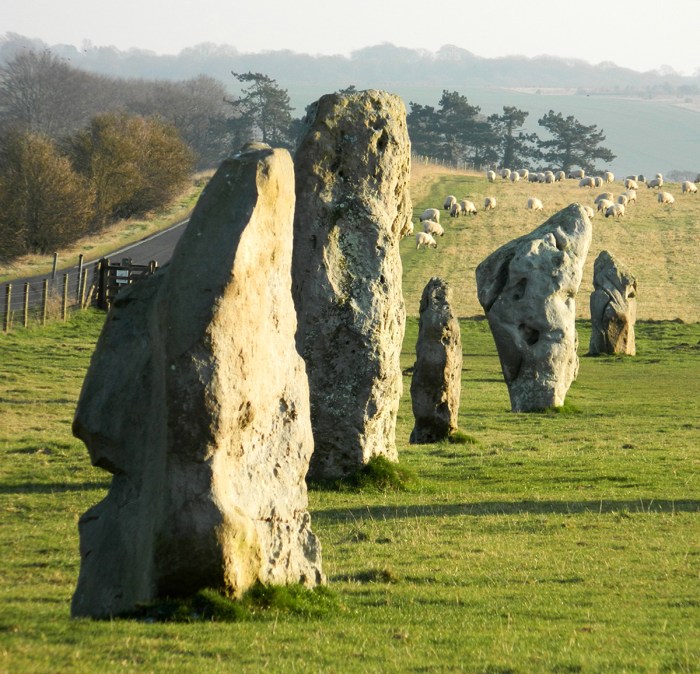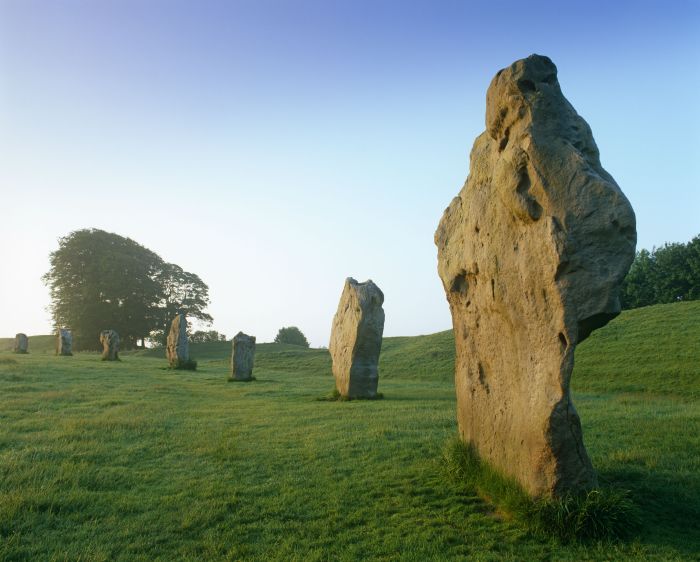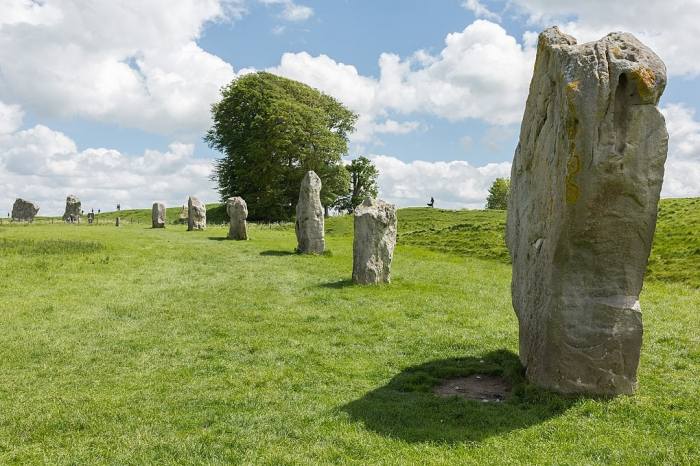At the heart of the Wiltshire countryside lies Avebury, a Neolithic masterpiece that has captivated hearts and minds for centuries. As we embark on a journey through its ancient stones and vibrant history, we unravel a tapestry woven with human ingenuity, ritualistic practices, and the enigmatic wisdom of our ancestors.
From its humble beginnings as a Neolithic settlement to its designation as a UNESCO World Heritage Site, Avebury’s story is a testament to the enduring power of human culture and the enduring legacy of our past.
Neolithic Origins

Avebury’s origins lie in the Neolithic period, around 2850 BC. It was a significant settlement during this time, and its inhabitants constructed an impressive henge monument that remains a prominent feature of the landscape today.
Construction of the Henge
The Avebury henge is one of the largest in Britain, with a diameter of around 1,100 feet. It was built using massive sarsen stones, some of which weigh up to 40 tons. The henge was likely constructed in several stages, with the earliest phase dating to around 2850 BC. The outer circle of stones was added later, around 2600 BC.
Purpose of the Henge
The purpose of the Avebury henge is not fully understood. It is thought to have been a ceremonial or ritual center, and may have been used for gatherings, feasts, and other social events. The henge may also have had astronomical significance, as its alignment with the summer solstice sunrise suggests that it was used to mark the changing of the seasons.
Daily Life of the Neolithic Inhabitants
The Neolithic inhabitants of Avebury lived a simple life, based on farming and hunting. They lived in roundhouses made of wood and thatch, and their diet consisted of crops such as wheat, barley, and beans, as well as meat from animals such as sheep, pigs, and cattle.
Rituals of the Neolithic Inhabitants
The Neolithic inhabitants of Avebury practiced a variety of rituals, many of which were associated with the henge. These rituals may have included sacrifices, feasts, and dances. The henge may also have been used for divination or other forms of spiritual practice.
Avebury’s Stone Circles

Avebury is renowned for its impressive stone circles, each with its own distinct characteristics and significance. These circles have captivated the imagination of historians, archaeologists, and visitors alike, offering glimpses into the beliefs and practices of the Neolithic people who constructed them.
Avebury, an ancient Neolithic site in Wiltshire, England, is renowned for its intriguing stone circles and enigmatic history. Its significance extends beyond its local confines, inspiring hikers worldwide. If you’re seeking the best hiking trails in the US, be sure to explore our curated guide here.
Immerse yourself in the breathtaking landscapes and discover the hidden gems that make Avebury and the US hiking trails unforgettable.
The Outer Circle
The Outer Circle is the most prominent and awe-inspiring of the three circles. It consists of approximately 100 massive sarsen stones, each weighing up to 40 tons and standing up to 13 feet tall. The stones are arranged in a roughly circular shape, with a diameter of around 1,100 feet. The Outer Circle is believed to have been constructed around 2600 BC and served as a ceremonial or ritual space.
The Great Circle
Within the Outer Circle lies the Great Circle, a smaller but equally impressive stone circle. It consists of approximately 30 sarsen stones, each weighing up to 30 tons and standing up to 10 feet tall. The Great Circle is believed to have been constructed around 2500 BC and may have been used for astronomical observations or religious ceremonies.
The South Circle
The South Circle is the smallest of the three circles and is located just south of the Great Circle. It consists of approximately 20 sarsen stones, each weighing up to 20 tons and standing up to 7 feet tall. The South Circle is believed to have been constructed around 2400 BC and may have been used for rituals or ceremonies related to the dead.
The alignment of the stones in the Avebury circles is believed to have astronomical significance. The Outer Circle is aligned with the sunrise on the summer solstice, while the Great Circle is aligned with the moonrise on the same day. These alignments suggest that the circles may have been used to track the movements of the sun and moon and to mark important celestial events.
The construction of the Avebury circles required immense effort and organization. The stones were quarried from a nearby site and transported to Avebury, where they were erected using a combination of人力 and ingenuity. The precise methods used to move and erect the stones remain a mystery, but it is clear that the Neolithic people who built them possessed remarkable skills and determination.
The Avebury Landscape

Avebury is located in a landscape of rolling hills, chalk downlands, and river valleys. The surrounding area is rich in archaeological sites, including the West Kennet Long Barrow and Silbury Hill.
The natural features of the area influenced the development of the settlement. The chalk downlands provided a source of building materials, while the river valleys provided a source of water. The hills also offered a defensive position.
West Kennet Long Barrow
The West Kennet Long Barrow is a Neolithic burial mound located about 2 miles west of Avebury. It is one of the largest and most impressive long barrows in Britain.
- The barrow is about 350 feet long and 80 feet wide.
- It is made of earth and chalk rubble.
- The barrow contains a chamber that was used for burials.
Silbury Hill
Silbury Hill is a Neolithic artificial mound located about 1 mile north of Avebury. It is the largest prehistoric mound in Europe.
- The hill is about 130 feet high and 580 feet in diameter.
- It is made of earth and chalk rubble.
- The purpose of the hill is unknown, but it may have been used as a ceremonial center.
Relationship to Other Neolithic Sites
Avebury is part of a network of Neolithic sites in the region. These sites include Stonehenge, Woodhenge, and Durrington Walls.
- These sites are all located within a few miles of each other.
- They are all thought to have been built around the same time.
- They may have been used for religious or ceremonial purposes.
Avebury in Later Periods

Following the Neolithic period, Avebury continued to be occupied and used for various purposes, leaving its mark on the site’s history.
Bronze Age, Avebury
During the Bronze Age (c. 2500-800 BCE), Avebury remained an important ceremonial and ritual center. The construction of the Kennet Avenue, a two-mile-long avenue of standing stones leading from Avebury to the River Kennet, dates to this period. The avenue likely served as a processional route for religious ceremonies.
Iron Age
The Iron Age (c. 800 BCE-43 CE) saw the establishment of an Iron Age hillfort within the henge. The hillfort was surrounded by a massive earthwork and ditch, and served as a defensive stronghold for the local population.
Roman Period
During the Roman occupation of Britain (43-410 CE), Avebury became part of the Roman province of Britannia. The Romans constructed a road through the site, connecting Silchester to Bath. The road bisected the henge and the Kennet Avenue, disrupting the original layout.
Avebury, a Neolithic henge monument, is a fascinating historical site. Its intriguing stone circles and earthworks offer a glimpse into the past. For those interested in exploring the darker side of history, a visit to the Alcatraz East Crime Museum in Tennessee provides an immersive experience into the world of crime and punishment.
Upon returning to Avebury, one can reflect on the stark contrast between the ancient monument and the modern museum, gaining a deeper appreciation for the complexities of human history.
Medieval and Modern Times
In medieval times, Avebury was a thriving village. The henge was used as a pasture for livestock, and the stones were often quarried for building materials. In the 17th century, the antiquarian John Aubrey visited Avebury and made detailed drawings of the site, helping to preserve its historical significance.
In the 19th and 20th centuries, Avebury became a popular tourist destination. The site was excavated and restored, and is now protected as a Scheduled Ancient Monument.
Avebury, with its enigmatic stone circles, is a historical marvel. For a change of pace, consider exploring the enchanting coastal region of 30a Florida , where pristine beaches and emerald waters await. Afterward, return to Avebury’s ancient mysteries, marveling at the enduring legacy of its Neolithic ancestors.
Archaeological Excavations
:max_bytes(150000):strip_icc()/aerial-image-of-avebury--neolithic-monument--site-of-a-large-henge-and-several-stone-circles--unesco-world-heritage-site--wiltshire--england--united-kingdom--europe-100376667-5b50ca1cc9e77c00372327db.jpg?w=700)
Archaeological excavations at Avebury have played a crucial role in uncovering the rich history and significance of the site. Extensive excavations conducted over the past two centuries have provided invaluable insights into the construction, use, and evolution of the Avebury monuments.
Early Excavations
The first major excavations at Avebury were undertaken by Alexander Keiller in the early 20th century. Keiller’s work focused on the central area of the henge, where he uncovered evidence of a large timber circle that predated the stone circle. He also excavated several of the surrounding barrows, revealing burials and artifacts that shed light on the funerary practices of the Neolithic inhabitants.
Recent Excavations
In recent decades, excavations at Avebury have been led by a team from the University of Southampton. These excavations have concentrated on the outer areas of the henge, as well as on the surrounding landscape. They have uncovered evidence of a complex network of ditches, pits, and other features that suggest the site was used for a variety of ritual and ceremonial purposes.
Ongoing Research
Archaeological research at Avebury is ongoing, with new excavations and surveys planned for the coming years. These investigations aim to further our understanding of the site’s construction, use, and significance in the Neolithic period. Ongoing research focuses on the relationship between the Avebury monuments and the surrounding landscape, as well as the role of the site in the wider context of Neolithic Britain.
Future Excavation Plans
Future excavation plans at Avebury include a detailed survey of the outer ditch system and the excavation of several barrows within the henge. These excavations are expected to provide further insights into the construction and use of the site, as well as the lives of the people who built and used it.
Avebury as a World Heritage Site
Avebury’s exceptional cultural and historical significance has been recognized by UNESCO, which designated it as a World Heritage Site in 1986. This prestigious recognition acknowledges Avebury’s outstanding universal value and the need to preserve and protect it for future generations.
Criteria for Inclusion
Avebury’s inclusion on the World Heritage List was based on the following criteria:
- Criterion (i): Avebury represents a unique and exceptional example of a Neolithic monument complex, showcasing the architectural and engineering skills of its ancient builders.
- Criterion (ii): The site provides valuable insights into the cultural, religious, and ritual practices of Neolithic societies, contributing to our understanding of human history.
- Criterion (iii): Avebury bears exceptional testimony to the cultural traditions of the Neolithic period, demonstrating the continuity and evolution of human settlement and cultural practices.
- Criterion (iv): The site is an outstanding example of a large and well-preserved Neolithic monument complex, providing a valuable resource for studying the development of prehistoric societies.
Preservation and Protection
As a World Heritage Site, Avebury is subject to rigorous preservation and protection measures. The UK government, local authorities, and conservation organizations work together to ensure the site’s integrity and authenticity for future generations. This includes:
- Protecting the physical structures of the monuments from damage or alteration.
- Managing visitor access and tourism to minimize the impact on the site.
- Undertaking archaeological research and monitoring to deepen our understanding of Avebury and its history.
- Raising awareness of the site’s significance and encouraging public appreciation and support.
By preserving and protecting Avebury, we not only safeguard an invaluable piece of our human heritage but also ensure that future generations can continue to learn from and appreciate this extraordinary archaeological treasure.
Visitor Information

Avebury is a fascinating and accessible historical site that welcomes visitors from around the world. To make the most of your visit, here’s some practical information to help you plan your trip.
Access
Avebury is conveniently located in Wiltshire, England, with good access by road and rail. By car, take the A4 from London or the A303 from the west. By train, the nearest station is Swindon, with regular services from London Paddington and other major cities. From Swindon, you can take a bus or taxi to Avebury.
Tours
Guided tours of Avebury are available throughout the year. These tours provide an in-depth look at the site’s history, archaeology, and significance. Tours typically last around 90 minutes and cost around £10 per person. To book a tour, contact the Avebury Visitor Centre.
Visitor Facilities
The Avebury Visitor Centre is located in the heart of the village and offers a range of facilities for visitors. These include a museum with exhibits on the history of Avebury, a shop selling souvenirs and books, and a café serving refreshments. The visitor centre is open daily from 10am to 5pm.
Itineraries
There are several ways to explore Avebury and the surrounding area. Here are a few suggested itineraries:
- Half-day visit: Start with a guided tour of Avebury, then visit the museum and shop at the visitor centre. Finish with a walk around the village and a bite to eat at one of the local pubs or cafés.
- Full-day visit: In addition to the half-day itinerary, visit the nearby Silbury Hill, a mysterious ancient earthwork. You can also take a walk or bike ride in the surrounding countryside.
- Multi-day visit: Stay in one of the local bed and breakfasts or hotels and explore Avebury and the surrounding area at your own pace. Visit the nearby towns of Marlborough and Devizes, or take a day trip to Stonehenge.
Closure: Avebury
Avebury stands as a testament to the enduring power of human ingenuity and the enduring legacy of our past. As we continue to unravel its secrets and appreciate its timeless beauty, we are reminded of our own place in the grand tapestry of history.
User Queries
What is the significance of Avebury’s stone circles?
Avebury’s stone circles are believed to have had astronomical and ceremonial significance. The alignment of the stones suggests they may have been used to track the movement of the sun and moon, while their positioning within the landscape indicates they may have been part of rituals connected to the changing seasons.
What is the connection between Avebury and other Neolithic sites in the region?
Avebury is part of a wider network of Neolithic sites in the region, including Stonehenge and Silbury Hill. These sites are believed to have been connected by ancient pathways and may have served as centers for trade, ritual, and social gatherings.
What is the current status of archaeological research at Avebury?
Archaeological research at Avebury is ongoing, with excavations and surveys continuing to uncover new insights into the site’s past. Recent discoveries have shed light on the daily lives of the Neolithic inhabitants and the construction techniques used to create the stone circles.